 [Home] → [Records] → [Tierra del Fuego]
[Home] → [Records] → [Tierra del Fuego]
Tierra del Fuego, a journey on the research vessel Meteor
Prologue
1. Quarantine in Santiago de Chile
2. On Board
3. Under water
4. Hard times
Epilogue
Further reading
Prologue
My journey with the research vessel Meteor into the intricate fjord landscape of Tierra del Fuego was a special experience that gave me unforgettable impressions, but also made me feel the adversities that can be associated with such undertakings harshly and mercilessly. Adventures so far away from home can easily make you realise how small we are and how big our planet actually is, when in the worst case it is not possible to be home within one day. Although it is not clear from the following description, we were about sixty people from different nations and institutes on board. However, I will only report here from my point of view and prefer to tell our story rather than write a scientific treatise on our activities. Should you be interested in technical information about our expedition, I can warmly recommend a click on the links listed at the end. Now I wish you much pleasure and a good journey...
1. Quarantine in Santiago de Chile
It was early January 2022, the global Corona crisis was far from over, and so we were only allowed to board the plane with a negative PCR test. We were approaching Santiago de Chile airport, where our adventurous journey was to begin.
As the Chilean authorities took the situation very seriously, all passengers arriving from abroad had to undergo another PCR test immediately after arrival, even before they could get to their luggage and go through customs. Afterwards we were escorted to the hotel, where we had to stay in self-isolation until we would receive the test results. These fortunately came the next morning, whereupon I set off for breakfast, enjoying the early morning rays of the summer sun that had risen here - until I was abruptly pulled out of my morning ritual of coffee and fruit.
One of my colleagues tested positive at the airport after all, so we all had to return to our rooms and no one knew exactly what would happen next. In the end, we spent a few more days in our quite comfortable hotel room until we were transferred to a Corona reception centre in the city under the strictest hygienic conditions. It was a former hotel of old, once noble, providing accommodation for the wealthier people in the capital, now just a property on which the marks of neglect were clearly visible and which had been converted into a medically supervised epidemic ward. Here we spent another week under regular physiological observation and extremely miserable food conditions until we were finally released. - Wait, not all of us. Fate did not spare my teammate. Although he still tested negative at the airport, he must have caught it in our quarantine and was held up with a positive result when we were discharged. Our case, because of which the group was held up, also did not have permission to travel on. While we were allowed to continue our journey to Punta Arenas, they had to stay in their rooms for another week. How hard can it actually hit you?
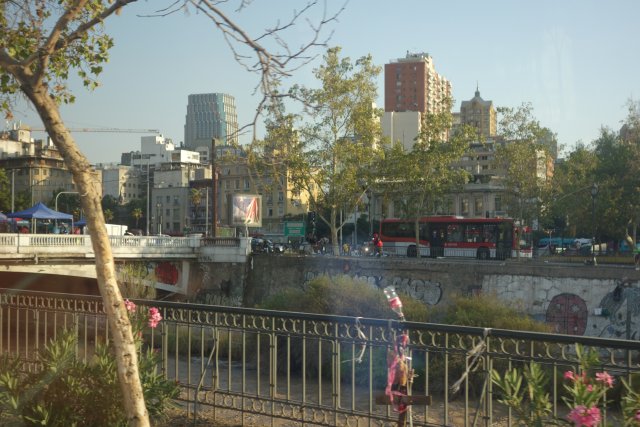
Santiago de Chile on the way to the city centre
2. On Board
Arriving in Punta Arenas, the largest settlement in southern Chilean Patagonia, on the shores of the Strait of Magellan, we finally reached our destination. Without any further stops, we were taken by a small pilot boat to the research vessel Meteor, anchored in front of the harbour where we would work, live and pursue our research mission for the next few weeks.
I work for Polar and Marine Research at the Alfred-Wegener-Institute in Bremerhaven. My job is to coordinate and carry out the development of remotely operated underwater robots and their use on expeditions. On this cruise we looked at the colonisation of the seabed in the Strait of Magellan, the Beagle Channel, Cape Horn and the adjacent fjords. The aim was to take stock of the prevailing ecosystem and compare it with previous recordings in order to document changes over time and, if possible, relate them to changing environmental conditions.
Now back to our expedition and our new home. The Meteor is a medium-sized research vessel with a length of just under 100 m that offers space for about 28 scientists and 32 crew members. Like many of the German research vessels, the hull shines in classic blue, from which the white superstructures stretch upwards. The orange cranes, lifeboats and chimney form a prominent contrast to the blue and white. The deck is kept in light green, but only reveals itself to the observer from on board or from the air. She was completed in the 80s, which can still be seen in the somewhat nostalgic interior. Although the ambience exudes the charm of a pop-coloured Alibert, it is not uncomfortable and even offers some luxury.
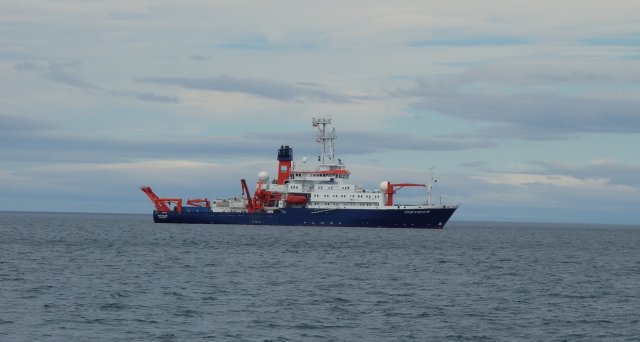
RV Meteor
It took me a few days to unpack our equipment, set it up and carry out various functional tests that were essential for a successful dive. In a small room next to the working deck I was able to install the operations centre, a hodgepodge of countless screens with various video images, measurement and navigation data, computers for control and data recording, video recorders, control devices and communication equipment to keep in touch with the bridge and the working deck, in order to operate the underwater robot we used on this voyage. In technical jargon, these devices are flown, and the operator is therefore called a pilot. A ROV (Remotely Operated Vehicle) that I adapted and modified for our mission. So it is a remotely operated underwater drone that provides video images from four cameras, navigation data for position and orientation, and also records water properties such as temperature, pressure, salinity, oxygen, pH, chlorophyll and light intensity. It is also equipped with a sonar and an altimeter to detect obstacles from a distance at an early stage.
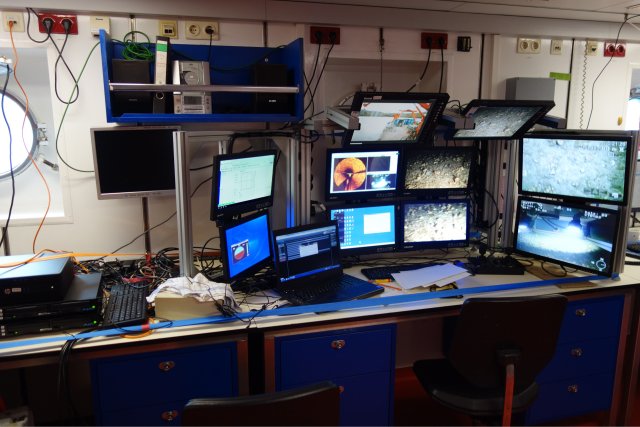
ROV control centre
For the crew and my colleagues, I set up a video network with the help of the onboard electronics technicians and the system administrator, so that a live image of the underwater operations could be followed on the oversized screen in the dry lab. This led to a regular cinema event, which was enthusiastically received. The bridge was not neglected either and was provided with a video stream from the ROV control centre. Excited about the first pictures, we awaited the first dive with great curiosity.
The Meteor had already left the port of Punta Arenas and is on a westerly course following the Strait of Magellan. After a few nautical miles, we turned to port into one of the fjords that end at a glacier or glacier bed. It all depends on how much and how long the rising temperatures have been gnawing away at it, and how the rate of increase due to snowfall is lower than its rate of melting.
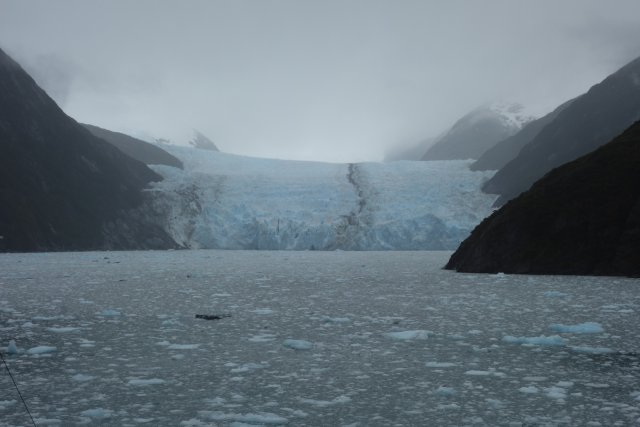
Glacier front in Garibaldi Fjord
A breathtaking landscape with snow-capped peaks rising several thousand metres into the sky, the last foothills of the Andes stretching from the north along the coastline throughout Chile. Partially steep giants with almost vertical walls form gorges down to the valley bottoms at the foot of the fjords. A canopy of glistening white peaks and ridges merges into a rocky and grassy zone below the snow line. Further down the valley, a dense rainforest extends to the coastline. Few people, if any, have had the pleasure of entering these landscapes. Leaning against the railing, I often felt the urge to just saddle up my backpack, get into my walking shoes and continue my way overland. Although the weather this far south is very changeable with lots of clouds, fog and rain, there were also wonderful sunny days to brighten the mood. Occasionally we had a visit from seals, whales and various species of birds that startled everyone, and those who could leave work for a brief moment to greet our guests. I was often drawn to the deck in the solitude of the night to enjoy the moment of silence and the sounds of the world around us. When everything was quiet, I could listen to the crackling of the melting ice floes or the rushing and splashing of the countless streams and small waterfalls...

Panoramic view of the fjord landscape of Tierra del Fuego
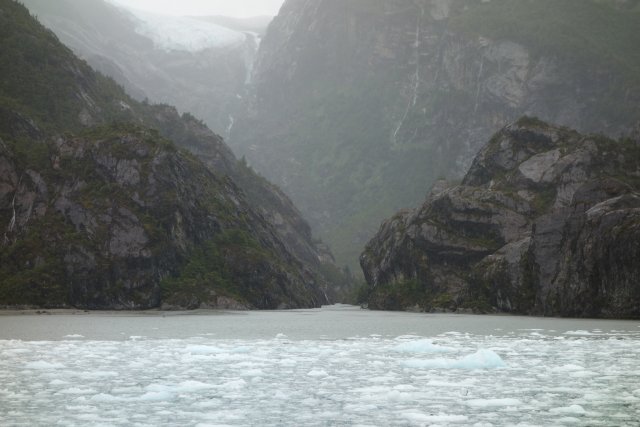
Gorge on the edge of the Fjord Garibaldi
3. Under water
The procedure for a mission is usually the same, always in the hope that everything will go well and there will be no unpleasant surprises, which I have experienced far too often in the course of my work. Actually, there hasn't been an expedition on which something hasn't gone wrong, which usually banishes me to the workshop for several days and nights to work out a temporary solution with the limited options on board. After all, there are no possibilities to order spare parts or have them delivered on the road, and I have to make do with what I have stowed away in the countless boxes beforehand. At this point, I didn't know that this trip would be no exception and would still give me a severe headache. At the beginning, however, there were no surprises worth mentioning, somewhat unusual for a research instrument that had just been screwed together in the lab and not yet tested.
The first mission: The working deck has been instructed, which means that the sailors on deck know what to do in order to take all the necessary steps when launching and recovering the robot. What happens outside is coordinated and directed by the boatswain, the highest-ranking crew member on deck. The bridge respectively the duty officer has been informed about the operation plan and has given his approval. In rare cases, the captain also does the honours and operates the ship during the dive. All final operational tests have been successfully completed, and all systems are working as expected. The ship's side thrusters and propeller have been turned off so that the ship only drifts with the current, making the relative movement between ship and ROV negligible. After the absolutely necessary and unavoidable "go" from the bridge, we are ready to dive.
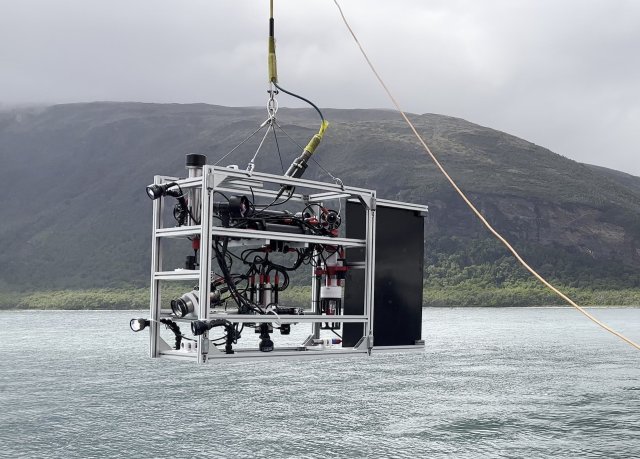
ROV during deployment
With extreme caution and care, the cranes and winches are set in motion. Slowly, the robot lifts off and floats over the railing out to the open sea. As soon as a sufficient safety distance to the board wall is reached, the mobile observatory can be lowered into the water. Now, depending on the water depth, the more or less lengthy descent into the ocean begins. As a rule, the vertical flight towards the seabed takes about ten to fifteen minutes, however, it takes longer with increasing depth. According to the diversity of species in the water, all kinds of objects race pass the camera, mostly plankton or the so-called marine snow. Sometimes you are lucky and a school of fish accompanies you a little way into the eternal darkness of the sea. Since the water depths are often only vaguely known and the ship's own echo sounders only have a certain accuracy, the seabed usually appears unexpectedly in the video image. Slowly, what was at first a washed-out grey changes into clearer contours, getting closer and closer to the glow of the illumination and gaining colour with decreasing distance. Only now does the structure of the ground reveal itself. Soft sediment, a difficult terrain for sessile organisms that only find a foothold on the few stones that, like small oases in a desert, give life a chance. Mobile seabed dwellers such as crabs, starfish and snails are the only travellers that seek a way through the soft bottom here and there. Such wastelands are formed either where sediment can be deposited due to current conditions, but especially where it is transported into the water by streams and glaciers. Partly far up in the mountains, where the ice streams make their way through the valleys, the frozen freshwater giants grind ceaselessly against the massive rock and send the resulting debris on its journey into the depths of the oceans.
A completely different picture emerges on the steep slopes of the fjords, where the fine sediments find no support or are carried away by the current. Life flourishes there as long as enough food is brought in from of plankton or other nutrients from the vast oceans. Numerous representatives of the most diverse families fight for the rare space on the rocky outcrops. A forest of pink cold-water corals, blue glowing sea cucumbers, yellow sponges and many other sea creatures provide shelter for fish, crabs, mussels and various species of brittle stars. In depths which are still illuminated by a few rays of sunlight, a shimmering green carpet of algae covers the metropolis of animal settlers.
In the marginal areas exposed to the forces of the open sea, where tidal currents, surf and windswept seas set the pace, filter feeders like mussels and brachiopods feel particularly at home. They feed tirelessly on the smallest particles brought by the tides. Near Cape Horn, where the Atlantic meets the Pacific, countless crabs cavort, also interested in the rather small food portions of the richly laid table. With a lot of luck, one occasionally catches sight of a rare guest, but since most sea dwellers are fundamentally sceptical of us intruders, only the bravest among them dared to approach our camera.
My personal highlights were small black octopuses that, out of sheer excitement, secreted equally large clouds of ink to disguise their whereabouts. They couldn't fool a full-grown Homo sapiens, though, but luckily for them, we were just observers, and they had nothing to fear. I was delighted to see a small shark and the clear boss of the area, a ray about two metres long, completely unafraid and abruptly filling the entire camera frame. He came so close to our ROV as if he wanted to show us who was in charge here. A powerful and impressive representative of its species, it must have had a wingspan of more than a metre.
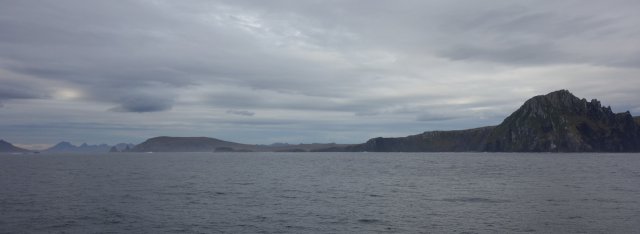
Cape Horn
Soaking up these impressions, we made our way from station to station through the Strait of Magellan, turned south into the Beagle Channel and stopped in Ushuaia, one of the southernmost cities in the world. During our trip, our two colleagues who had stayed behind in Santiago had managed to get to Argentina by land and finally to Ushuaia. Here we were finally able to pick them up for the second half of the expedition. But annoyance turned into frustration and, in the end, into a disaster. Only one had made it on board. My much anticipated colleague and scheduled cabin mate still tested positive before boarding the ship and was therefore not let on board. He had to go home and return to Germany without having achieved anything. I felt so incredibly sorry for him, an exhausting Atlantic crossing, more than two weeks in quarantine, a Corona infection, the several thousand-kilometre journey from Santiago de Chile to Ushuaia and then sent home again. As far as I know, he even had to deal with late effects of his infection.
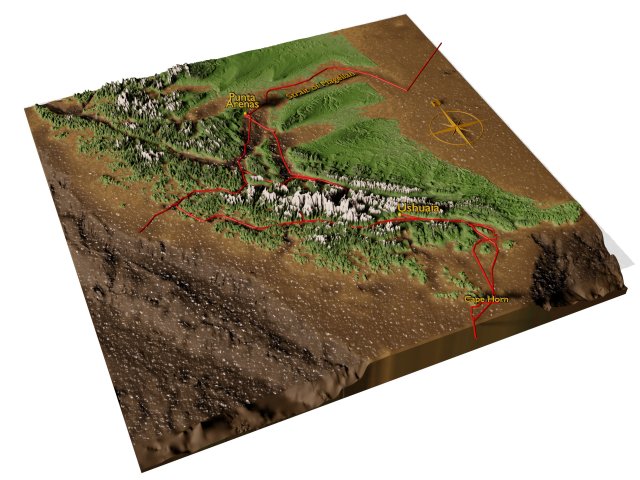
Track of the Meteor cruise M179/2
4. Hard times
So we set sail without him until fate struck me. Far away from civilisation, on the other side of the world, I received the news that my very pregnant partner had been admitted to hospital with complications. Completely exhausted and agitated, like a restless cat of prey in its cage, I did my rounds on the ship and almost went crazy. My deepest thanks and respect goes to the crew of the Meteor, who did everything they could to provide me with satellite phone, internet connection, communication priorities and emotional support until I received the relieving news that she were released to go home, with the requirement to get plenty of rest. Friends and relatives have thankfully taken over my duties and looked after her in my absence. Thank you very much for that, I will not forget you. Even if I could have headed straight home, I probably wouldn't have arrived any sooner. Corona measures, reduced and completely overbooked flights, not to mention the distance to the nearest airport could also have easily led to an even longer adventure.
So back to work. But the next disaster was not long in coming. The fibre optic cable, the vital communication line of our robot, was damaged and could no longer be repaired with the available resources on site. The next crisis meeting. But for almost every problem, there is a temporary solution. After several days and nights of headaches, I was able to create a temporary solution with a replacement cable, a second winch and two pulleys, which at least allowed us to complete a few more missions.
After finishing our station work, we called at the port of Punta Arenas again and released about half of our colleagues. Personally, I had to travel on to Montevideo for another five days, which gave me enough time to dismantle everything again and stow it in the containers. Now it was time to return home, because after such a journey you can get fed up and just want to go home to your family and your sacred place on the sofa.
Epilogue
About a month later, my daughter Marie Sophie was born healthy and happy. In the meantime, she has brought me a lot of joy and shown me that life offers also completely different adventures. When I think back to the time when we sailed around Cape Horn, I see things with different eyes today. Despite the hardships, exhausting efforts and unforgettable impressions, the expedition was basically a complete success, and as is so often the case, everything somehow turns out all right in the end. Legend has it that sailors who have sailed around the Cape of South America no longer have to bow to the Queen. But legends are only legends after all...
Further reading
About the research vessel Meteor
For scientific data, I recommend the Alfred Wegener Institute's data archive Pangaea keyword search "M179/2".
last update: 19 Oct 2023 08:53
